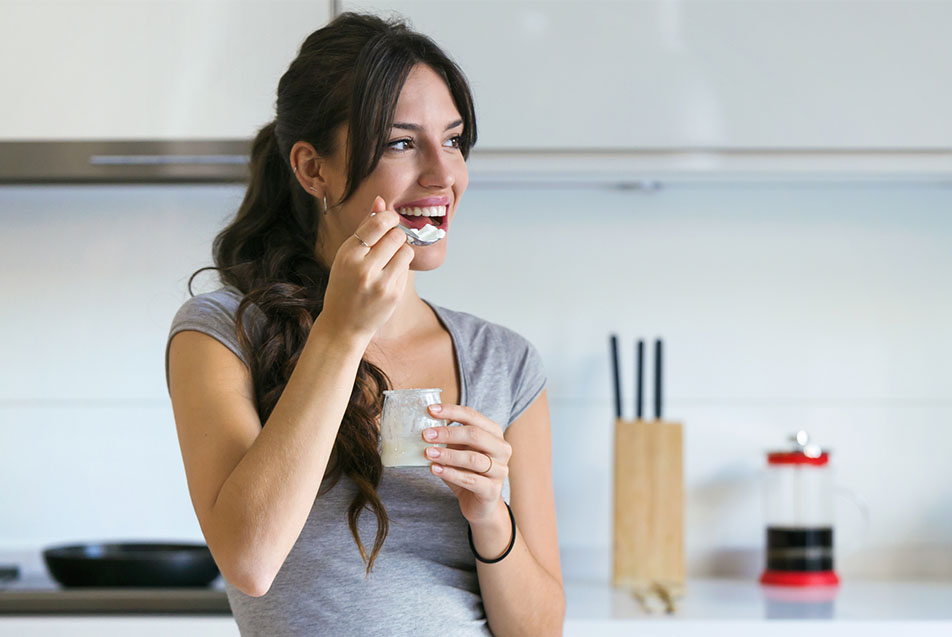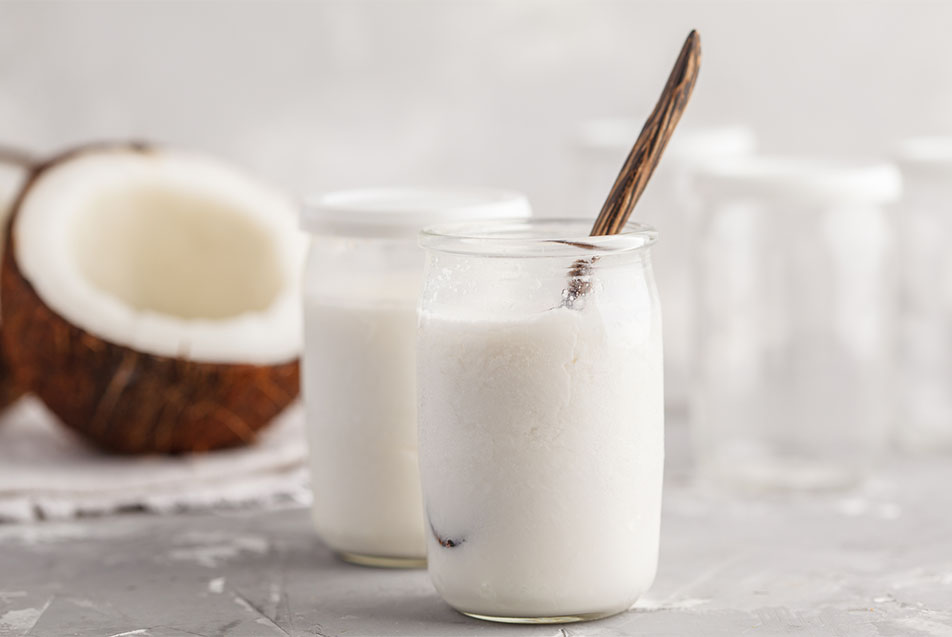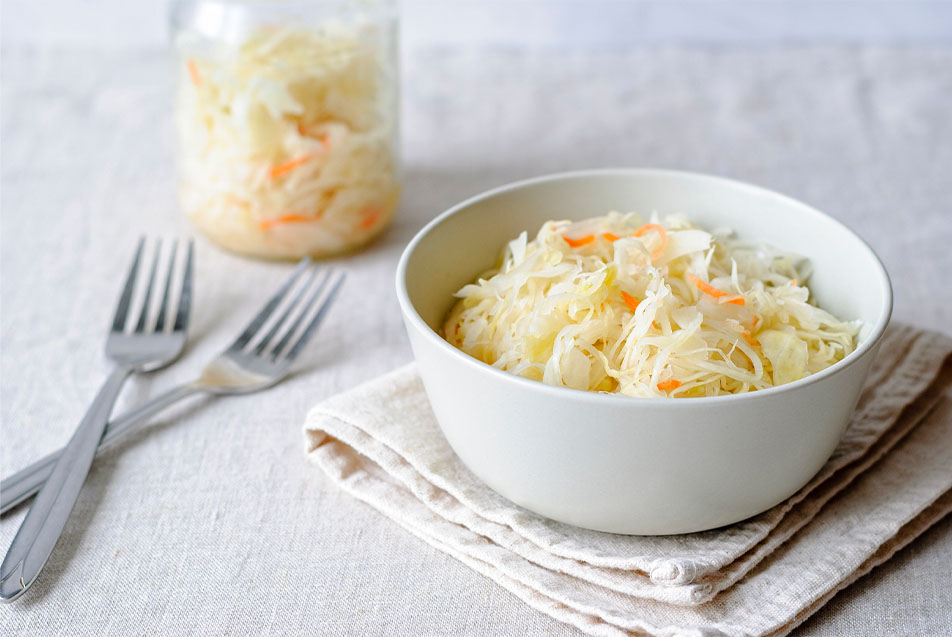
There’s been a great deal of chatter in the wellness community as of late about gut health and, more specifically, the possible benefit of probiotics for gut health. We take a deeper dive into this buzzworthy topic (and share some delicious recipes as a bonus).
People typically associate the word “bacteria” with germs, illness or some other negative health experience. But probiotics — strains of beneficial bacteria that reside in the intestinal tract — are actually good for you.
"There is an increasing interest in probiotic interventions," wrote the authors of one of the most recent studies, a meta-analysis of previous research featured in the Journal of the American Medical Association. Those researchers found that probiotics were particularly useful against a common gastrointestinal problem: antibiotic-associated diarrhea (AAD). But studies show that probiotics can help with a great deal more, including warding off infection and boosting immune systems, improving women’s health and perhaps even fighting obesity.
The word "probiotic" is a compound of two Greek words: "pro" (promotion of) and "biotic" (life). Their very definition is something that affirms life and health. That's true even by modern standards. The World Health Organization defines a probiotic as, “any living microorganism that has a health benefit when ingested.” Similarly, the USDA defines a probiotic as, “any viable microbial dietary supplement that beneficially affects the host.”
That doesn't mean that all probiotics, or probiotic-containing foods are created equal. So what should you look for? "There is a lot of 'noise' in this space as more and more 'food products' are coming out with probiotics," Dr. Shekhar K. Challa, a gastroenterologist and author of Probiotics For Dummies tells The Huffington Post. "Unfortunately it is impossible to quantitate the CFUs of probiotics in most food products."
CFUs, or colony-forming units, is a microbiological term that describes the density of viable bacteria in a product. In other words, the CFU tells you how rich in probiotics a food actually is and how much will be available to your body.
Dr. Challa recommends a serving of the following unpasteurized probiotic-rich foods each day:
- Plain unflavored yogurt
- Kefir
- Sauerkraut
- Miso
- Pickles
- Tempeh
- Kimchi and
- Kombucha tea
Each of us has more than 1,000 different types of bacteria that live in our digestive tracts, helping us to break down food and absorb nutrients. But when we take antibiotics (medicine that is designed to kill destructive, illness-causing bacteria), the drugs can also kill the healthy intestinal flora that helps us digest. About 30% of the patients who take antibiotics report suffering from diarrhea or some other form of gastrointestinal distress, according to the recent JAMA study on probiotics and antibiotic-associated diarrhea. As a result, doctors commonly prescribe taking probiotics to "repopulate" the digestive tract with healthful bacteria. The study found that it was a viable solution for many.
But probiotics can also help with other types of digestive issues. Research has shown that probiotics can be helpful for people with irritable bowel syndrome (IBS), a hard-to-treat condition that can have a range of intestinal symptoms, such as abdominal pain, cramps, bloating, diarrhea and constipation. In one study, female IBS patients experienced some alleviation of symptoms like abdominal pain and irregularity when they were given a supplement of the bacterial strain, Bifidobacterium infantis. This works when the good bacteria helps "crowd out" bad bacteria. That's because the intestine is lined with adherence sites where bacteria latches on. If the sites are populated with good-for-you microbes, there's no place for a harmful bacterium to latch on.
Probiotics are best known for their role in digestive health, but research has shown that they can help many other aspects of your health. Here’s some of the evidence.
Health benefits of probiotics
Immunity. Beneficial bacteria in your intestines crowd out harmful bacteria and have a direct effect on your immune response. Unfortunately, changes in gut bacteria occur as we age, particularly a decline in Bifidobacteria, which inhibit pathogenic microbes. This increases susceptibility to colds, flu and infections. Probiotics can help restore it.
The health benefits of probiotics are also helpful if you are prescribed an antibiotic. Antibiotics kill the beneficial bacteria along with the harmful. When these protective bacteria are wiped out, pathogenic bacteria and other organisms move in. This can cause diarrhea, as well as yeast overgrowth in the vagina and intestines. If you must take an antibiotic, probiotics can help offset these negative side effects.
Gastrointestinal health. The health benefits of probiotics not only reduce antibiotic-associated diarrhea, they’re helpful for diarrhea and constipation associated with irritable bowel syndrome (IBS) and for ulcerative colitis, Crohn’s disease and other inflammatory bowel diseases.
Obesity. Research suggests that probiotics may help fight obesity. The bacteria that reside in your intestinal tract are involved in nutrient uptake and energy regulation. Studies reveal that in obese humans and animals, these bacteria extract and absorb more calories from food and store them in fat cells. Distinct differences have also been noted in the microbial communities of obese and thin people. The health benefits of probiotics are no magic bullet for weight loss, but supporting your gut bacteria appears to reduce inflammation and other markers of obesity.
Diabetes. Supplemental probiotics have been shown to delay the onset of glucose intolerance in animals, and, in a 2010 human study, L. acidophilus supplements had a positive effect on insulin sensitivity. Furthermore, some researchers found that people with type 2 diabetes have different gut bacteria than those without diabetes.
Depression and anxiety. Some research has found that when your gut bacteria are out of balance (dysbiosis), it can affect your mood. For example, anxiety gives us butterflies and stress ties our stomach in knots. Thanks to the gut-brain connection, Lactobacillus and perhaps other strains appear to tone down the stress response and improve anxiety and depression.
Skin. The journal Gut Pathogens also published an article highlighting the links between intestinal bacteria, mood and acne. The authors note that there is an established connection between skin conditions and mood disorders (acne is associated with depression and anxiety), and that acne is also linked with gastrointestinal problems (adolescents with acne are at higher risk for several GI symptoms). In other words, your brain, skin and immune system are all physiologically intertwined, mediated by gut bacteria. Other studies have found links between intestinal bacteria and psoriasis.
Oral health. Research suggests the health benefits of probiotic supplements may help control bad breath and promote better oral health overall. More specifically, Lactobacillus, Bifidobacterium, and other strains help curb growth of bacteria such as Streptococcus mutans that contribute to bad breath, cavities and gum problems.
So, how can you maintain or increase the amount of probiotics in your body?
First, eat plenty of prebiotics (indigestible carbohydrates that beneficial bacteria thrive on). Fiber-rich fruits and vegetables, onions, artichokes, whole grains and garlic, in particular, stimulate the growth of gut flora. Also consume fermented foods such as yogurt, kefir, miso, sauerkraut, kimchi and pickled vegetables. They contain live, healthy bacteria that help populate the intestinal tract.
Second, take a probiotic supplement. Popular strains of probiotics are Lactobacillus (L. acidophilus, L. plantarum, and L. rhamnosus), Bifidobacteria (B. bifidum and B. longum) and Saccharomyces boulardii (a yeast used to treat diarrhea).
When selecting a probiotics supplement look for one that not only protects these delicate “good” bacteria, but also ensures they reach your entire intestinal tract, amplifying the health benefits of the probiotics. It's important to remember that these beneficial bacteria are live organisms and won’t do you any good if they are dead. When buying a supplement: .
·Check the expiration date. You don’t want a supplement that has exceeded the lifespan of the organisms it contains.
·Get enough CFU. Probiotic potency is measured in colony forming units. Look for a dose of 10 to 20 million CFUs, a common range in clinical trials.
·Maintain proper care. To preserve their integrity, probiotics need to be kept in a cool, dry place away from air. This is why I prefer probiotics that are sold refrigerated and kept in your fridge at home.
·Be consistent. Your digestive tract is a volatile environment and daily probiotic use will ensure that you are doing your best to maintain its optimal state.
Always check with your pediatrician before starting your child on any supplement.
Fermented foods, such as yogurt, are often missing from our daily diets. Good bacteria can be found in these foods, which help strengthen the overall gut health and improve the immune system. They also aid in the reduction of inflammation in the body and realign the gut’s natural flora. This particular yogurt recipe is higher in beneficial bacteria than traditional store-bought yogurt, without the added sugar. Enjoy the benefits of natural foods.
Recipes

Homemade Coconut Yogurt
1 32-ounce mason jar (or any glass container with a secure lid)
1 can original full fat organic coconut milk
2 probiotic capsules with live cultures of your choice
1 cup fresh strawberries, blackberries, blueberries or raspberries, for topping
Drizzle maple syrup, for topping
1 handful of chopped nuts (optional) for topping
1. In a 32-ounce jar, combine coconut milk and a high quality probiotic by opening the capsules and pouring the probiotic powder directly into the coconut milk. Discard the capsules. Close the lid tightly and shake.
2. Store the container in a cool, dark corner on the kitchen counter away from heat, for three days, shaking periodically. After three days, the yogurt is ready to be served. For thicker yogurt, refrigerate the jar/mixture for up to one week. Refrigerated, thickened yogurt should be stirred prior to serving. (This is a more kefir-like yogurt.)
3. Top with desired fruit, maple syrup and/or nuts and enjoy.
Makes 2 servings
Another method is to put the sealed jar of yogurt in the oven with the light on for 24 hours. Do not turn the oven on. Just close the oven door and turn on the oven light. The closed oven and the light generate a stable temp of about 105-110 degrees, perfect conditions for the coconut milk to incubate.
Note: If the yogurt doesn’t culture, one of two things may have happened: 1) the lid was not properly sealed, or 2) various brands of probiotics affect the recipe differently. For the next recipe, replace the probiotic capsules with a different option. You can also use a store brand coconut milk yogurt as a starter or the yogurt you made as a starter and stir in 1 tablespon coconut milk yogurt per 1 cup of coconut milk. (I use 2 tablespoons yogurt per whole can of coconut milk.)

Homemade Sauerkraut
Cutting board
Chef's knife
Mixing bowl
2-quart widemouth canning jar (or two -quart mason jars)
Canning funnel (optional)
Smaller jelly jar that fits inside the larger mason jar
Clean stones, marbles, or other weights for weighing the jelly jar
Cloth for covering the jar and a Rubber band or twine for securing the cloth
1 medium head green cabbage (about 3 pounds)
1 1/2 tablespoons kosher salt or sea salt
1 tablespoon caraway seeds (optional), for flavor
1. Clean everything: When fermenting anything, it's best to give the good, beneficial bacteria every chance of succeeding by starting off with as clean an environment as possible. Make sure your mason jar and jelly jar are washed and rinsed of all soap residue. You'll be using your hands to massage the salt into the cabbage, so give those a good wash, too.
2. Slice the cabbage: Discard the wilted, limp outer leaves of the cabbage. Cut the cabbage into quarters and trim out the core. Slice each quarter down its length, making 8 wedges. Slice each wedge crosswise into very thin ribbons.
3. Combine the cabbage and salt: Transfer the cabbage to a big mixing bowl and sprinkle the salt over top. Begin working the salt into the cabbage by massaging and squeezing the cabbage with your hands. At first, it may not seem like enough salt, but gradually, the cabbage will become watery and limp — more like coleslaw than raw cabbage. This will take 5 to 10 minutes. If you'd like to flavor your sauerkraut with caraway seeds, mix them in now.
4. Grab handfuls of the cabbage and pack them into the canning jar. If you have a canning funnel, this will make the job easier. Every so often, push down the cabbage in the jar with your fist. Pour any liquid released by the cabbage while you were massaging it into the jar. (Optional: Place one of the larger outer leaves of the cabbage over the surface of the sliced cabbage. This will help keep the cabbage submerged in its liquid.)
5. Once all the cabbage is packed into the mason jar, slip the smaller jelly jar into the mouth of the jar and weigh it down with clean stones or marbles. This will help keep the cabbage weighed down, and eventually, submerged beneath its liquid.
6. Cover the mouth of the mason jar with a cloth and secure it with a rubber band or twine. This allows air to flow in and out of the jar, but prevents dust or insects from getting in.
7. Over the next 24 hours, press down on the cabbage every so often with the jelly jar. As the cabbage releases its liquid, it will become more limp and compact and the liquid will rise over the top of the cabbage.
8. If after 24 hours, the liquid has not risen above the cabbage, dissolve 1 teaspoon of salt in 1 cup of water and add enough to submerge the cabbage.
9. Ferment the cabbage for 3 to 10 days (14 days is even better). As it's fermenting, keep the sauerkraut away from direct sunlight and at a cool room temperature — ideally 65 – 75 degrees. Check it daily and press it down if the cabbage is floating above the liquid.
Because this is a small batch of sauerkraut, it will ferment more quickly than larger batches. Start tasting it after 3 days. When the sauerkraut tastes good to you, remove the weight, screw on the cap, and refrigerate. You can also allow the sauerkraut to continue fermenting for 10 days or even longer. There's no hard and fast rule for when the sauerkraut is "done".
While it's fermenting, you may see bubbles coming through the cabbage, foam on the top, or white scum. These are all signs of a healthy, happy fermentation process. The scum can be skimmed off the top either during fermentation or before refrigerating. If you see any mold, skim it off immediately and make sure your cabbage is fully submerged; don't eat moldy parts close to the surface, but the rest of the sauerkraut is fine.
10. This sauerkraut is a fermented product so it will keep for at least two months and often longer if kept refrigerated. As long as it still tastes and smells good to eat, it will be. If you like, you can transfer the sauerkraut to a smaller container for longer storage.
Makes 1-1 1/2 quarts
Recipe notes:
• Sauerkraut is great with red cabbage, Napa cabbage and other options as well. Make individual batches or mix them up for a multi-colored sauerkraut!
• You can process sauerkraut for longer storage outside of refrigeration, but the canning process will kill the good bacteria produced by the fermentation process.
• To make larger or smaller batches of sauerkraut, keep same ratio of cabbage to salt and adjust the size of the container. Smaller batches will ferment more quickly and larger batches will take longer.
•Do everything you can to store sauerkraut at a cool room temperature. At high temperatures, the sauerkraut can sometimes become unappetizingly mushy or go bad. Low temperatures (above freezing) are fine, but fermentation will proceed more slowly.
Recipe resource:
The Kitchn